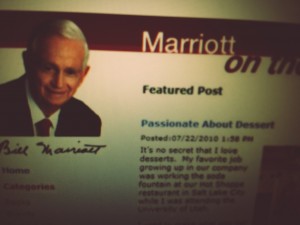on March 13 | in All, Marketing | by Doriane Mouret
During this 5 article series, we’ve been through the long process of building a good corporate blog, and learned how to avoid the most common mistakes that would make a corporate blog fail, from strategy, to User Experience, through messaging and tone. We learned how not to fail, but now it’s time to learn how to succeed fast and efficiently. The reasoning is pretty simple: just forget what you’ve read up until now. To succeed, you need to stand out; to stand out, you need to be different; and to be different, you need to think out of the box, and implement strategies that have never been implemented before. You need to be bold and take risks which a majority of bloggers don’t dare to do: that’s what I call “the leader’s complex.”
5. Getting the Leader’s complex
In any marketing strategy, “being the first” is crucial in order to have your campaign stand out. Dropbox is a great example of a company that took advantage of both its position as a pioneer in the market of consumer cloud storage and the absence of potential competitors to get consumers’ attention. Beyond having a great product, Dropbox took the initiative to implement a social media strategy that had rarely been tried before – it was between 2007 and 2009.
The DropBox Story
A Community without a Product. The first innovation tried by Dropbox founders Drew Houston and Arash Ferdowsi was to build a community before the product was actually released. While many companies wait to have a fully launched and market-ready product before rallying their core users, Drew and Arash tested landing pages and a private beta program with early adopters that became their main evangelists afterwards.
A Video promoted on an Aggregator. The second brilliant idea released by the company co-founders happened when they launched their viral marketing video. No, I agree, creating a marketing video was not innovative, even in 2009. But the innovation came through the way they decided to share it: they launched a campaign on Digg, a website usually used to bookmark articles. “At the time, Dropbox was closed. After the video went viral, our beta waiting list went from 5,000 people to 75,000 in a few hours,” Drew explained.
Thus, using an innovative social media strategy can be highly beneficial to your business. The downside comes with the risk taken to implement that strategy. Indeed, if Dropbox hadn’t satisfied their early adopters, they were taking the risk of spreading a negative image of their product among a group of people highly influential in the industry.
When sharing content, these risks usually show when you transcribe unheard or unpopular opinions on your blog. Bloggers who think “out of the box” take the risk of being damned by the community, or even ignored. But if their ideas are relevant and founded, they could also become strong thought leaders. When blogging for a company, this risk is transferred to the organization. Thus, if your ideas fail at rallying the general opinion, you can damage your brand irreversibly. However, if it works, you will place your company in a strong position for the future.
Be Bold
Afterall, blogging works like life: whether you decide to do what has already been done, which won’t make you stand out but will ensure you acceptable results, or you attempt to execute an innovative strategy, taking the risk to fail, or succeed. Here are a few unconventional blogs that succeeded thanks to innovative teams ready to make some “bold moves”:
 Marriott on the Move. In my third article, I explained how letting the CEO of a company be the main writer could have bad consequences on a blog strategy. Not only does it make your company rely on the CEO’s image, but it can also harm your brand if the CEO is not a good writer. Those details didn’t stop the hotel chain Marriott International whose blog “Marriott on the move” is written by Mr. Bill Marriott himself. And it works! Each article receives between 10 to 20 comments in average, showing a community of engaged readers that take time to share ideas and leave long comments.
Marriott on the Move. In my third article, I explained how letting the CEO of a company be the main writer could have bad consequences on a blog strategy. Not only does it make your company rely on the CEO’s image, but it can also harm your brand if the CEO is not a good writer. Those details didn’t stop the hotel chain Marriott International whose blog “Marriott on the move” is written by Mr. Bill Marriott himself. And it works! Each article receives between 10 to 20 comments in average, showing a community of engaged readers that take time to share ideas and leave long comments.
On the go with Amy. Hiring a social media expert or a full-time blogger to create your corporate blog content was another main point of my third post. I highly dissuade to externalize your content development to someone that doesn’t belong to your company. The external blogger doesn’t come to the office everyday, therefore isn’t involved in the company culture and can miss some important changes in the company strategy. And there is nothing worse than a blog saying something that doesn’t align with your strategy. Best Western decided to try nonetheless by giving control of their corporate blog to Amy Graff, a long time fan – but not employee – of the company. In “On the go with Amy“, Amy talks about her travel experiences with her family, which drives a high level of engagement.
full-time blogger to create your corporate blog content was another main point of my third post. I highly dissuade to externalize your content development to someone that doesn’t belong to your company. The external blogger doesn’t come to the office everyday, therefore isn’t involved in the company culture and can miss some important changes in the company strategy. And there is nothing worse than a blog saying something that doesn’t align with your strategy. Best Western decided to try nonetheless by giving control of their corporate blog to Amy Graff, a long time fan – but not employee – of the company. In “On the go with Amy“, Amy talks about her travel experiences with her family, which drives a high level of engagement.
 The Old New Things. In my first article, I explained how defining a relevant strategy when building your blog was crucial in order to make the most of it for your company, hence driving sales. I recommended to focus on creating relevant content for your readers, but also gave you tricks to incorporate your brands and your products in that content. That’s indeed a safe strategy to make sure your executives and investors see how your corporate blog can bring value to the company. Well, The Old New Thing doesn’t do that at all. The Old New Thing is an MSDN blog written by Raymond Chen, Principal Software Design Engineer at Microsoft. Raymond only shares his expertise and honest opinion in his posts, without promoting or linking to any Microsoft websites. It’s true, it’s sincere, and it works. No strategy, just good honest content.
The Old New Things. In my first article, I explained how defining a relevant strategy when building your blog was crucial in order to make the most of it for your company, hence driving sales. I recommended to focus on creating relevant content for your readers, but also gave you tricks to incorporate your brands and your products in that content. That’s indeed a safe strategy to make sure your executives and investors see how your corporate blog can bring value to the company. Well, The Old New Thing doesn’t do that at all. The Old New Thing is an MSDN blog written by Raymond Chen, Principal Software Design Engineer at Microsoft. Raymond only shares his expertise and honest opinion in his posts, without promoting or linking to any Microsoft websites. It’s true, it’s sincere, and it works. No strategy, just good honest content.
 Nuts About SouthWest. I really appreciate blogs such a the LinkedIn blog, with a clear, simple and seamless design. As I stated in my fourth article, simplicity enables faster page loading, and keeps your reader focused on the content. The airline company SoutWest doesn’t seem to worry too much about that, and decided to build one of the heaviest blogs I have ever seen: tons of images and videos everywhere, and a minimum of 10 calls-to-action on any given page. Some would think that this blog is far from offering a seamless user experience, but it’s an opinion that the recurring visitors and fans of Nuts About SouthWest don’t seem to share.
Nuts About SouthWest. I really appreciate blogs such a the LinkedIn blog, with a clear, simple and seamless design. As I stated in my fourth article, simplicity enables faster page loading, and keeps your reader focused on the content. The airline company SoutWest doesn’t seem to worry too much about that, and decided to build one of the heaviest blogs I have ever seen: tons of images and videos everywhere, and a minimum of 10 calls-to-action on any given page. Some would think that this blog is far from offering a seamless user experience, but it’s an opinion that the recurring visitors and fans of Nuts About SouthWest don’t seem to share.
 Dell on Google+. When starting a blog, it’s essential to build an entire social media strategy around it in order to optimize your exposure. The common plan is usually to build a Facebook fan page, create a Twitter handle and encourage the visitors of your corporate blog to “Like you on Facebook” and “Follow you on Twitter”. Well, forget that! Facebook and Twitter are so 2011! Dell decided to bet on the next trendy social network: Google+. The Direct2Dell blog doesn’t feature any Facebook page, and Twitter only gets some attention at the bottom of the page, while Google+ gets to have a prominent window at the top. Going “all in” on Google+ is bold, and Direct2Dell could be missing out some interesting Facebook traction as a result, but if Google+ becomes the next big thing in 2012, it will give the company a significant competitive advantage in terms of social media strategy. [UPDATE 05/08/2012] The Direct2Dell blog doesn’t highlight its Google+ page anymore: It was probably a temporary campaign to increase the number of followers on Google+.
Dell on Google+. When starting a blog, it’s essential to build an entire social media strategy around it in order to optimize your exposure. The common plan is usually to build a Facebook fan page, create a Twitter handle and encourage the visitors of your corporate blog to “Like you on Facebook” and “Follow you on Twitter”. Well, forget that! Facebook and Twitter are so 2011! Dell decided to bet on the next trendy social network: Google+. The Direct2Dell blog doesn’t feature any Facebook page, and Twitter only gets some attention at the bottom of the page, while Google+ gets to have a prominent window at the top. Going “all in” on Google+ is bold, and Direct2Dell could be missing out some interesting Facebook traction as a result, but if Google+ becomes the next big thing in 2012, it will give the company a significant competitive advantage in terms of social media strategy. [UPDATE 05/08/2012] The Direct2Dell blog doesn’t highlight its Google+ page anymore: It was probably a temporary campaign to increase the number of followers on Google+.
According to a study conducted by HubSpot, companies that blog get 55% more traffic. But the study doesn’t mention all the work required apart from just building a blog platform in order to get this extra traffic. During this 5 article series, I tried to highlight the different aspects of building a corporate blog, and I hope I convinced some of you to think twice about your blog strategy. Now it’s time for you to choose. If you follow the recommendations given in the first 4 articles, your corporate blog will bring you interesting results, but you will never make your company a rock-star in the corporate blogging world. If you decide to be innovative and follow the advice of the fifth article, you take the risk of making your blog strategy fail, but you also open the door to new opportunities for success. Your turn: so what do you choose?
« 5 Reasons Why Corporate Blogs Fail – #4 Bad UX No Means Yes, And Yes Means… »
